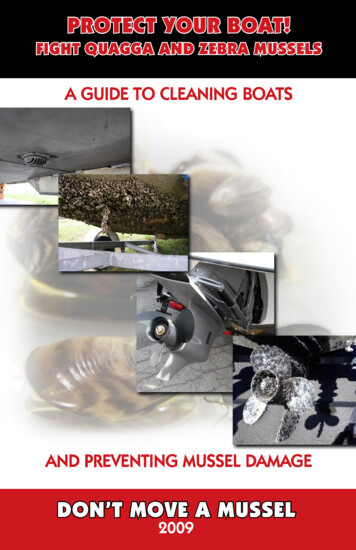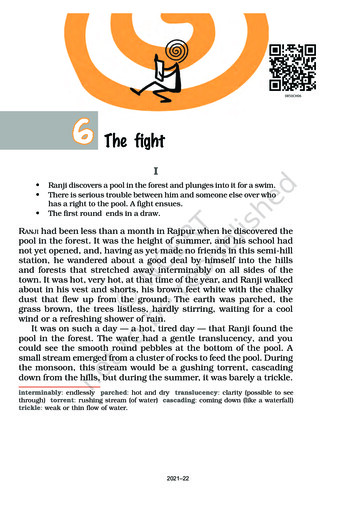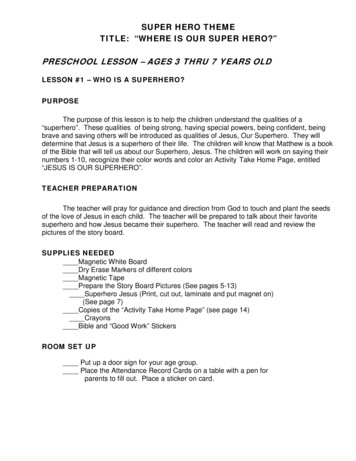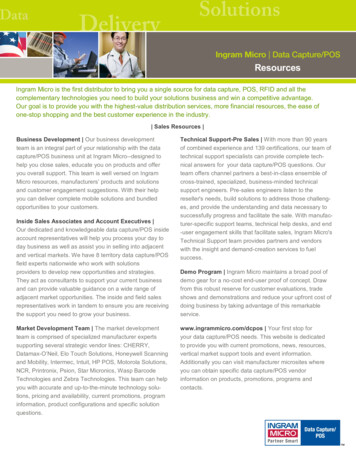
Transcription
PROTECT YOUR BOAT!FIGHT QUAGGA AND ZEBRA MUSSELSA GUIDE TO CLEANING BOATSAND PREVENTING MUSSEL DAMAGEDon’t Move a Mussel!October 2009DON’T MOVE A MUSSEL20091
What is being done to contain theQuagga/Zebra?State and federal agencies have joined forces to avert further infestations of Quagga/Zebramussels and are urging boaters to help stop the spread of Quagga/Zebra mussels in California.A multi-agency taskforce, including the California Departments of Fish and Game, Boatingand Waterways, Water Resources, Parks and Recreation, and Food and Agriculture as wellas the U.S. Fish and Wildlife Service, U.S. Bureau of Reclamation, National Park Services,and many local governments and water agencies, has launched a statewide outreach campaign to alert the public – and particularly boat owners – about the Quagga/Zebra musselthreat.Boaters should be aware that laws now make it illegal to transport Quagga/Zebra mussels.Boats found with evidence of the mussels may be quarantined and boat owners may facefines in some states. Many local authorities have instituted mandatory inspection programsat their lakes and reservoirs. Contaminated or suspect boats are being turned away.California Department of Fish and Game1416 9th Street, 12th FloorSacramento, CA 95814(866) s to Utah State Parks for their photographic contributions.The California Department of Fish and Game is an equal opportunity employer.An alternate communication format is available upon request. If reasonable accommodation is needed,call 916-322-8911 or the California Relay (Telephone) Service for the hearing‑impaired from TDDphones at 1‑800‑735‑2929 or 711.Don’t Move a Mussel!October 20092
Protect Your Boat!Keep Freshwaters Open to Boatingand Fishing!How can you help fight the Quagga/Zebra mussel invasion?Boater and watercraft users can stop the mussels from spreading.This guide was compiled specifically for boat owners and watercraft users. The informationcontains general guidelines for all boaters and a basic checklist for inspecting and cleaning boats and recreational equipment for Quagga/Zebra mussels. There are also additionalinspection and cleaning checklists for specific types of boats and equipment. By taking thetime to inspect and clean your boat, you can: Protect your boat, the aquatic environment, and the boating facilities you use (marinas,gas docks, piers). Keep waterways open for recreational boating and fishing. Prevent an economic disaster resulting in millions of dollars in damage to water transport facilities. Comply with state and federal laws regarding the spread of Quagga/Zebra mussels.Quagga/Zebra mussels have invaded the West!California’s waterways currently face an enormous challenge: an invasion by Quagga mussels (Dreissena rostriformis bugensis) and Zebra mussels (Dreissena polymorpha). Zebramussels, a native species of Eastern Europe, were first introduced in the United Statesthrough ballast water released into the Great Lakes in the late-1980s. Quagga mussels soonfollowed.Great efforts were made to prevent the spread of these fresh water mollusks west of the100th Meridian. In January 2007, Quagga mussels were discovered in Lake Mead and later inother reservoirs of the Lower Colorado River. Now they infest water bodies in Riverside, SanDiego, Imperial and Orange counties. In January 2008, Zebra mussels were discovered inSan Justo Reservoir in San Benito County. The spread of these mussels to additional California waters will seriously impact the state’s aquatic environment and water delivery systems,endangering recreational boating and fishing.Don’t Move a Mussel!October 20093
What do they look like?Quagga/Zebra mussels vary in color and often have dark and light stripes on their shells.They differ in size, from microscopic young to adults an inch or two in length. These invasivemussels cluster in huge colonies.Zebra mussels next to dime.Zebra mussels at San Justo Reservoir (right/below)Various sizes of Quagga/Zebra mussels.Photos San Benito County Water DistrictQuagga/Zebra mussels could severely reduce recreationalboating and fishing activities if more waters become infested.Don’t Move a Mussel!October 20094
Quagga/Zebra mussels pose serious threatsQuagga/Zebra mussels may be tiny, but are highly destructive infreshwater systems because they can: Reproduce quickly and in very large numbers, up to 1 million larvae per spawning season.Colonize on both hard and soft surfaces, from the water’s surface to more than 400 feetdown, including boat hulls, propellers, anchors, docks, and boat trailers.Coat submerged surfaces such as piers, pilings, rocks, cables, boat ramps, docks, lines,pipes and fish screens, increasing maintenance costs.Infiltrate and damage boat engines, bilges, live wells, and steering components.Threaten the state’s water treatment plants, hydroelectric plants, and reservoirs.Clog municipal water intake structures and obstruct the flow of drinking water.Cost taxpayers millions of dollars to repair damaged pipes and water transport facilities.Wreak havoc on the environment by disrupting the food chain by filtering the watercolumn of phytoplankton and out-competing other species, including sport fish andendangered species.Change water conditions, causing heavier aquatic plant growth, oxygen loss, and fishkills.Result in infested waters being closed to boating and fishing altogether.Once Quagga/Zebra mussels are established, in most cases itis impossible to eradicate them with current techologies.How do Quagga/Zebra mussels ruin boats?Quagga/Zebra mussels produce larvae (called veligers) too small to see with the naked eye.Newly settled young feel like sandpaper on smooth surfaces. As they quickly grow larger,Quagga/Zebra can be seen on boat hulls, especially around trim tabs and transducers alongkeels, and on trailers, anchors, and propellers. The mussels can also be found in or on boatbilges, ballast water, live wells, motors, fenders, life jackets, ropes – basically anything thatcomes into contact with infested water and can serve as a reservoir or “pocket” in whichthey can survive.Quagga/Zebra mussels pose serious risks and costs to you as aboat owner because they can: Ruin your engine by blocking the cooling system and causing overheating.Increase drag on the bottom of your boat, reducing speed, and wasting fuel.Jam your boat’s steering equipment.Require you to scrape and repaint your boat’s hull.Don’t Move a Mussel!October 20095
The California Department of Fish and Game coordinates with the U.S. Geological Survey to generatea map of known locations of Quagga/Zebra mussels in the state. New locations are posted as soon assamples are positively identified. View the most current mussel/maps/CaliforniaDreissenaMap.jpgDon’t Move a Mussel!October 20096
General Guidelines: All BoatersIt is important for all boaters to cooperate with vessel inspections conducted at CaliforniaDepartment of Food and Agriculture Border Protection Stations and on waterways aroundthe state. Remember, you do not want to transport any Quagga/Zebra mussels from aninfested water body to another location currently free of Quagga/Zebra mussels. In addition,California law makes it illegal to transport these aquatic species, even if done so unintentionally.Trailered boats are the primary way that Quagga/Zebramussels are introduced to unconnected water bodies.After boating in any freshwater system: Carefully inspect, clean, and drain your boat when you leave the water, using thechecklists provided in this guide.All areas must be dry (including live wells) and clear of debris, and no standing watershould be on board your boat in any manner (including bait cans or buckets).Before traveling to any freshwater for boating: Inspect your boat for Quagga/Zebra mussels, which can survive five days out of waterin California’s hot summer and up to 30 days in cool, wet weather.If any residual water or mussels are discovered upon an inspection, clean your boatand all equipment using the same checklist procedures and let the vessel dry for five to30 days, depending on the weather, before you enter the water.Calculate your drying time e to clean your vessel can result in it being quarantined.Quagga mussels on boat hull found at California Border Protection Station.Photo California Dept. of Fish and GameDon’t Move a Mussel!General Guidelines: All BoatersOctober 20097Basic Inspection and Cleaning Checklist (over)
Basic Inspection and Cleaning Checklist:All WatercraftWhenever you leave freshwater, take the following actions:1.Remove the boat from the water and away from the launch ramp for vesselinspection and cleaning.2.Thoroughly inspect all exposed surfaces on your vessel and trailer. If you findany mussels, scrape them off and kill them by crushing them. Dispose of the remains inthe trash. Alert the Department of Fish and Game at 866-440-9530.3.Remove all plants and mud from your boat, trailer, and all equipment. Dispose of allmaterial in the trash.4.Carefully feel your boat’s hull for any rough or gritty spots, which may be youngmussels that have settled on your vessel and cannot be seen. Microscopic Quagga/Zebra mussels will feel like sandpaper.5.Away from the waterway, wash your boat’s hull, trailer, equipment, bilge, andany other exposed surfaces with high-pressure, hot water. When possible use waterat a temperature of 140 F (60 C) at the hull – or about 155 (68 C) at the nozzle– which will kill the mussels. Dry the boat as much as possible.6.Drain all water from your boat (pull all plugs) and dry all areas, including the motor, motor cooling system, live wells, ballast tanks, bladders, bilges, and lower outboardunits. Make sure that all life jackets, water skis or other items that have been in thewater, including anchors, ropes, etc., are inspected, cleaned, and dried.7.Empty and dry all buckets and dispose of all bait in trash receptacles before youleave. Do not take bait home, or leave it on the ground or dump it in any waterway.8.Thoroughly clean all fishing and recreational equipment (fishing nets, etc).9.Clean and dry personal belongings, clothing, and footwear that have come incontact with the water.10. Wash, dry, and brush pets that have been in the water.11. Keep your watercraft dry for at least five days in warm, dry weather and upto 30 days in cool, moist weather before launching into a freshwater.Day boats or those that “come and go” and spend only a few hours inthe water are still at risk for picking up and transporting mussels thatmay be attached to aquatic weeds. The basic cleaning steps apply toany and all watercraft.Additional steps for specific boats follow.Vessels that are slipped and moored at infested waters run greaterrisk of having settlers and adult mussels.Don’t Move a Mussel!October 20098
General Inspection and CleaningBoat Exterior: Entire hull, floor, transom wall, ballast tanks, ropes and lines, anchors,lights, pitot tube, depth sounders, trim tabs, cavitation plates, thru-hull fittings, depthtransducers, water intakes and outletsMotor: Entire exterior housing, propeller, propeller shaft, propeller shaft support, propellerguards, propulsion units, lower unit, gimbal area, water intakes and outletsBoat Equipment and Contents: All fishing nets and other fishing equipment, lines andropes, float belts, life jackets, float cushions, water skis and tow ropes, ski gloves, equipment lockers, waterfowl decoys and camouflage blinds, clothing and footwear, floats,fenders, dock guards inner tubes and other inflatable items, downriggers and other fishing equipment, bait containers/buckets and live wells, trolling motors, and internal ballasttanksTrailer: Trailer frame, axles, license plate and holders, lights and wiring, fenders, hangers,trailer tires and wheels, rollers and bunks, wiring, springs, pockets and hollow spacesPhotos Utah State Parksand California Departmentof Fish and GameDrain the engine, dry the motor well, check the propand system components, clean trolling motors, makesure everything is drained and dried. Remove allaquatic weeds.Be sure to check the trailer for aquatic weedsand other areas on the boat like bow lights.All vessels should be cleaned, drained, and dried!Don’t Move a Mussel!General Inspection and CleaningOctober 20099
Photos Utah State ParksCheck all areas listed under general inspection and cleaning. Feel the hull and check the trim tabs to ensureno standing water (veligers) or adults have taken hold. Check for weeds and other material as well.Photos California Department ofFish and GameVessels should be thoroughly cleaned. Those contaminated with mussels should be scraped, washed,drained and dried. Dry time may be between five daysin hot, dry California summers and up to 30 days incool moist weather.Check, clean, drainand dry live wells, alldrains, and any otherarea where water mightcollect.Remember: Most storm drains flow directly into rivers and otherwaters. Do not wash your vessel or drain it near a storm drain.To prevent illegal discharge of oil when draining or flushing the bilge, use oilabsorbents where possible. Oil absorbents should be disposed of as hazardouswaste in California. Call 800-253-2687 for drop off locations.Don’t Move a Mussel!October 200910
Water Ski Boats1.After completing the basic checklist, drain water from every internal ballast tanksystem as much as possible.2.Resume normal ballast system operation when you go boating again. Be sure towinterize the vessel when boating season ends.Southern California Marine AssociationSki boat covers open.California Department of Fish and GameBallast system waterpump, water lines,and caps shouldall be flushed andcleaned.Ski boat ballast water lines.Photos Utah State ParksTrim tabs ontransom.Follow these actions to stop mussels from growing inside the entire system.Failure to do so could result in restriction of water lines, overheating and pumpdamage, as well as the increased likelihood of needing to replace expensivesystem components.Don’t Move a Mussel!Water Ski BoatsOctober 200911House Boats, Pontoon Boats, and Other Large Vessels (over)
Houseboats, Pontoon Boats, and OtherLarge Vessels1.After completing the basic checklist, completely drain and dry all watersystems that use lake water including air conditioning, personal sanitation, andwashdown systems. Note: Vessel sewage must be disposed of at a pump-out facility ordump station. The longer the boat has been in the water, the higher the chance thesesystems have been contaminated.2.Take special care to protect system components including water supply anddischarge lines, filter screens, pumps, valves, and associated parts. Small passages inthe air conditioning radiator core are highly susceptible to being plugged by mussels.Southern California Marine AssociationAll areas that can hold water should be drainedand dried. Pontoons should be inspected formussels, settlers, and aquatic weeds that mayhave mussels attached.Photos Utah State ParksVessels should be thoroughly cleaned.Those contaminated with mussels shouldbe washed, scraped, drained and dried. Drytime may be between five days in hot, dryCalifornia summers and up to 30 days incool moist weather.Vessels that are slipped and moored at infested waters rungreater risk of having settlers and adult mussels.Don’t Move a Mussel!October 200912
Hulls should be inspected; all motors,intakes and any equipment that comesinto contact with the water should beflushed, washed, drained and driedwhether the equipment is attached tothe boat (like a slide) or unattached likeskis or floatation devices.Since large vessel water systems are located deep within thehull, they require extra effort to access, clean, and dry toprotect them. Failure to properly clean could result in costlyreplacement of system components if infestation occurs.Don’t Move a Mussel!Large Vessels continuedOctober 200913Sailboats (over)
Sailboats1.After completing the basic checklist, completely drain and dry all water systems that use lake water, including your air conditioning, personal sanitation, andwashdown systems. Note: Vessel sewage must be disposed of at a pump-out facility ordump station. The longer your boat has been in the water, the more likely the chancethese systems have been contaminated.2.Take special care to protect system components including water supply anddischarge lines, filter screens, pumps, valves, and associated parts. Small passages inthe air conditioning radiator core are highly susceptible to being plugged by mussels.3.Give special attention to the centerboard trunk, including the rudder and transom, keel and fittings, which is a major concern.4.Of special concern on sailboats is the removal of aquatic weeds. Remove allvegetation from the vessel.Vessels that are slipped and moored at infested watersrun greater risk of having settlers and adult mussels.Boaters should check their vessels for mussels andvegetation that could carry mussels. Some vegetationis an invasive species as well, like water hyacinth.California Department of Fish and GameDon’t Move a Mussel!October 200914
High Performance Speed Boats1.After completing the basic checklist, make sure that you flush your ‘external’cooling system. Flushing your system when retrieving your boat with fresh watersupplied by the marina or boat ramp you use may help eliminate the Quagga/ZebraMussel invasion.2.If your boat is not currently equipped with a ‘flush kit’ visit your local marineservice center for details. It is important for boat owners to recognize that the‘external’ system for cooling is the problem area and although many engine suppliersequip new boats with a ‘flush system’, not all do. Having a ‘flush kit’ installed correctly(typically by a marine engine service center) would address the problem. Many olderboats likely do not have a ‘flush kit’, but could have one installed.Closed cooling system.Photo Mercury MarinePhotos Southern California Marine AssociationDon’t Move a Mussel!High Performance Speed BoatsOctober 200915Personal Watercraft (over)
Personal Watercraft1.Avoid running craft through aquatic plants because this may damage the craft,plug water intakes, and increase mussel contamination.2.Stop the engine when water activities cease.3.Push or winch craft onto the trailer, without running the engine.4.Remove the craft from the water and away from the launch ramp for vesselinspection and cleaning.5.After completing the basic checklist, inspect and clean all of the systems andcomponents that apply specifically to the craft.6.Start and run the engine for five to 10 seconds to blow out water and contaminantsfrom the underbody jet drive system.7.Stop the engine and remove all plants, mud, and other contaminants from thesteering nozzle and the rest of the hull.8.Check underneath the craft for Quagga/Zebra mussels, especially the waterintake area (including the edges of the intake grate).9.Dry any pockets that may be wet or holding water.10. Drain any ballasts on the craft, rinse with hot water, and allow to dry.Photos Utah State ParksPersonal watercraft should be drained of allwater, washed, and dried.The steering nozzle should be inspected foraquatic weeds that might have mussels.Don’t Move a Mussel!October 200916
Kayaks, Canoes, and Inflatable Rafts1.After completing the basic checklist, inspect and clean any components thatapply specifically to the craft.2.Allow the craft to dry thoroughly before using it in any other water body.3.Take special care to dry inflatables before rolling them up.Photo California State ParksPhoto Utah State ParksKayaks, canoes and all inflatables need to becleaned, drained, and dried.Any equipment that goes into the waterneeds to be inspected and cleaned.Photo California Department of Fish and GameDon’t Move a Mussel!Kayaks, Canoes, and Inflatable RaftsOctober 200917Dive Gear (over)
Dive Gear1.Check all gear that could potentially hide any water (veligers) (include regulators, buoyancy compensation device, wetsuits, masks, gloves, boots, snorkels, and anyother dive gear).2.Thoroughly clean all regulators, BCDs, wetsuits, masks, snorkels, and anyother dive gear, making sure to clean both the inside and outside of the BCD toensure that no mud or organic matter is present – use a brush to scrub if necessary.3.After cleaning, rinse your suit, equipment and inside of BCD with hot ( 40 C or 104 F) or salt water (1/2 cup salt/gallon). Note, if you use the salt-watersolution, it is very important to thoroughly rinse the equipment in freshwater after yourcleaning because the salt crystals can harm your equipment. Divers can also use potassium at 100mg/liter at a temperature of 30 C, or using commercially available diveequipment cleaning compound that contains ammonia, vinegar, or chlorine. Dispose ofcleaning solution properly.4.Allow gear, suit, and other equipment to dry before diving in different waters.Veligers can survive on a wetsuit if left damp.5.If feasible, consider freezing your equipment overnight to kill any veligers.Remember: Most storm drains flow directly into rivers andother waters. Do not wash your vessel, equipment or gear ordrain it near a storm drain. Stop the spread of mussels!Don’t Move a Mussel!October 200918
Additional ResourcesFor more information: General information on Quagga/Zebra el/ Boat cleaning tips:http://100thmeridian.org/ General invasive species /InvasiveSpecies.cfmYou may also contact the following state departments foradditional information or assistance: Department of Fish and Game: 866-440-9530Department of Boating and Waterways: 888-326-2822Department of Water Resources: 916-653-9712Department of Parks and Recreation: 916-654-7538If you discover mussels in a new location, report it to theQuagga/Zebra hotline 866-440-9530California Codes that Apply to Quagga/Zebra Mussels Fish and Game Code § 2301 Specific to Dreissenid Mussels Includes both adults and water that may contain themTitle 14 CCR § 671 (F&G Code § 2118) Places restrictions on Importation, Possession and Transportation of Live AnimalsTitle 14 CCR §230 (f) and (h) Special conditions on tournaments to provide for welfare of fishThe law gives the California Department of Fish and Game theauthority to: Stop and inspect conveyances vehicles boats and other watercraft containers trailersOrder conveyances that contain water be drained, dried, or decontaminatedImpound or quarantine conveyancesRevoke or deny permits for failure to complyDon’t Move a Mussel!October 200919
DON’T MOVE A MUSSELEnjoy the water and the fishing!Support checkpoints!Don’t Move a Mussel!October 2009Help keep our waters clean!20
mussels, a native species of Eastern Europe, were first introduced in the United States through ballast water released into the Great Lakes in the late-1980s. Quagga mussels soon followed. Great efforts were made to p










